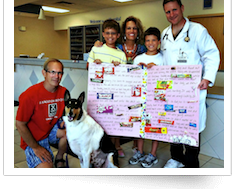Hyperthermia
Written by: Casey Alcorn, 3rd Year Veterinary Student • 2018 Scholar
History
 Duke is a 2 year 7 month old, intact male Pitbull. Duke presented on 6/28 to IVS with a history of ataxia (wobbliness), lethargy, inability to stand and vomiting. Owners were concerned about overheating. They had taken Duke for a long run. The owners used a bike and Duke ran beside/behind them for about 45 minutes. Once home, they let him sit by a vent and gave him water. He drank a lot of water, then vomited it up, and became ataxic. Owners said they did try to cool him with a cold bath before deciding to bring him into IVS.
Duke is a 2 year 7 month old, intact male Pitbull. Duke presented on 6/28 to IVS with a history of ataxia (wobbliness), lethargy, inability to stand and vomiting. Owners were concerned about overheating. They had taken Duke for a long run. The owners used a bike and Duke ran beside/behind them for about 45 minutes. Once home, they let him sit by a vent and gave him water. He drank a lot of water, then vomited it up, and became ataxic. Owners said they did try to cool him with a cold bath before deciding to bring him into IVS.
Physical Exam
Upon physical exam, Duke was depressed but responsive. He was carried in from the car on a stretcher due to his ataxia. His temperature was 104.3F (1-2 hours after the run, with a normal temperature being 101-102.5). Duke was tachycardic (high heart rate) with a heart rate of 180. Tremors, tachypnea (high respiration rate of 40) and ptyalism (drooling) were all noted. Systolic blood pressure was measured at 110 mmHg and ECG showed sinus tachycardia (normal blood pressure and heart rhythm). Mucous membranes were pink with a capillary refill time of less than 2 seconds. Body condition assessment was within normal limits. Duke had bleeding from his front nail beds, consistent with running on pavement for an extended period. No other abnormalities were noted.
Diagnostic Results
Dr. Hamersky diagnosed Duke with heat stroke due to excessive environmental heat. Due to his presenting temperature of 104.3F and his history of a 45-minute run, Dr. Hamersky assumed that Duke’s body temperature had been much higher. Thoracic radiographs were taken, but found to be within normal limits. ECG revealed sinus tachycardia, no other abnormalities were noted. Bloodwork revealed the following:
- Elevated HCT (high percentage of red blood cells; 61%) – most likely due to dehydration
- Thrombocytopenia (low platelets; although manual evaluation revealed adequate values) – we worry about DIC (disseminated intervascular coagulopathy)
- Elevated ALT (a liver enzyme; 231) – mostly likely due to hepatocellular necrosis (liver damage)
- Elevated Albumin (4.1) – due to dehydration
- Low potassium (2.9) – could be due to dehydration and vomiting
- Low phosphorus (1.5)
- With low Phosphorus, we worry about Duke’s ability to form ATP. Without ATP, he is likely to start lysing his red blood cells. ATP is the basic energy source for cells in the body
- Increased glucose (118) – likely due to stress
- Decreased pCO2 and Decreased HCO3 (metabolic changes)
- Respiratory alkalemia – most likely compensatory
- Metabolic acidosis – could be due to increased lactate in Duke’s system
- Coagulation evaluation revealed a normal PTT and a slightly elevated PT of 19 seconds (normal 11-17 seconds). PTT and PT are clotting times
- With elevated coagulation times, we worry about DIC
Treatment
An IV catheter was placed and 1 liter of Normosol-R was bolused. Heat stroke patients will not respond to antipyretics and active cooling measures must be used. The following mechanisms were initiated:
- IV fluids (single best way to get your patient’s temperature to decrease)
- Oxygen administration
- Isopropyl Alcohol on feet and ears
- Wet towel with a fan
- Fluids were then administered 350 ml/hr immediately after the 1 L bolus was finished
Duke’s recheck temperature was 101.9F and cooling efforts were stopped. It is dangerous to cool the patient too quickly as they can easily become hypothermic, but it can also cause the core temperature to actually increase. Systolic blood pressure recheck was 160 mmHg. ECG recheck showed normal sinus rhythm with 110 bpm.
- Maintenance fluids were reduced to 250 ml/hr
- KCl was added to maintenance fluids to help increase Duke’s potassium levels.
There are many systems affected with heat stroke patients. We also worry about gastrointestinal sloughing, rhabdomyolysis (breakdown of muscle), acute renal failure and neuronal damage. Duke was placed on the following medications to prevent GI sloughing and bacterial translocation:
- Metronidazole (an intestinal antimicrobial) 120ml IV q12
- Unasyn (broad spectrum antimicrobial) 85 ml IV q8
- Pantoprazole (proton-pump inhibitor used to cut down on stomach acid) 50 ml IV q12
- Cerenia (antiemetic) 5ml IV q24
Duke’s coagulation factors and platelets were monitored throughout his 24 hour hospitalization. When Duke’s temperature, PT, PTT and platelet count were within normal limits he was sent home.
Citations
- Tilley, LP, Smith, FWK. Blackwell’s Five-Minute Veterinary Consult: Canine and Feline (6th Ed). Ames, Iowa: Wiley Blackwell.
- Plunkett, Signe J. Emergency Procedures for the Small Animal Veterinarian (3rd Ed). Toronto, Ontario: Elsevier Ltd.
- William, Reece O. Duke’s Physiology of Domestic Animals (13th Ed). Ames, Iowa: Wiley Blackwell.




